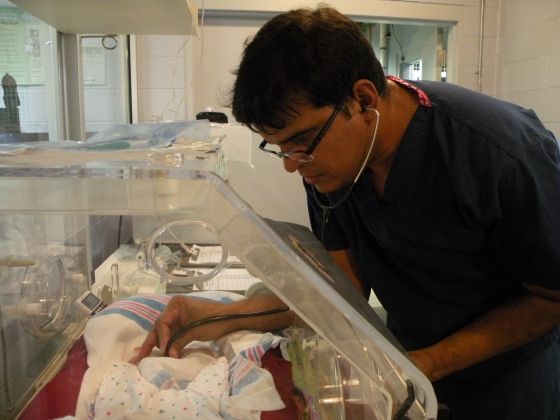From Cub Confidential We've got twin...BOYS
Twins are new to all of us, too! We’ve gotten some great questions about the rearing of the cubs. Rebecca Snyder, Ph.D., Curator of Mammals, took a few minutes to answer some of our more frequent inquiries.
1. What is the formula the cubs are getting, and how often are the cubs nursing?The formula is a combination of Esbilac® (a puppy formula) and Enfamil® (a human formula). This formula has been used successfully with many newborn giant panda cubs. Over the past day or so, neither of the cubs has required supplemental formula.
2. Why is the staff member not wearing gloves in some of the recent photos?Our staff disinfects their hands before touching the cubs. We are following the protocol used by the staff at the Chengdu Research Base of Giant Panda Breeding.
3. Why is the Zoo “intervening?” Wouldn’t Mom know best? Giant pandas normally do not raise both cubs when twins are born. It is normal for one cub to die within a few days of birth; this happens in the wild and in captivity. There are only two cases in which a captive giant panda mother has raised twins simultaneously. Both were experienced mothers, and both still had some human assistance. Humans watched the mothers constantly and retrieved a cub if it was dropped and gave it to the mother. It requires tremendous dexterity for a giant panda mother to keep her cub warm, clean, and fed. I think it is very difficult for the mother to do this for two cubs at once. She may try, but eventually one gets too cold or not enough to eat or is accidentally crushed. The best way to ensure that both cubs survive is to alternate them with the mother.
4. How does the staff go about actually rotating the cubs? When there is an opportunity to reach the cub, the staff member reaches in and removes the cub. Lun Lun is offered food when this happens. Giant panda mothers usually don’t eat or drink for a few to several days after birth, so food is not very motivating at this point. But, Lun Lun has been eating a piece of sugarcane when a cub is removed and sometimes drinks some water. She has food and water available to her at all times, but she is choosing not to eat and drink at other times. In a few days, her appetite will begin to return. Then she will start putting the cub down for short periods of time to eat and drink. The swapping can then be done when she puts the cub down. The Chengdu Research Base staff is very adept at this method, and it works very well.
5. How long will the cubs have to stay in an incubator? When not with Lun Lun, they will stay in an incubator for about two to three months. The temperature of the incubator will be reduced gradually as the cubs grow their coats and begin to be able to regulate their own body temperature. They are most vulnerable to hypothermia in the first month. After the first month, they have a full coat of fur and the mother puts them down more and leaves them for longer periods of time.
Vet Update July 18, Day 3:
July 18, Day 3: Sam Rivera, DVM, Associate Veterinarian, stayed up all night with the twins. He has this exclusive update for our Cub Confidential subscribers:
“The cubs and Lun Lun continue doing well. The cubs are gaining weight at a steady rate, and we can already tell how they are changing as they grow. Their white baby fur is getting longer, and we can see the dark coloration around the eyes.
The smaller cub is a handful! During the 1 a.m. swap, the smaller cub (which was in the incubator) let everyone know how hungry he was by screaming so loudly. I thought he was going to wake up all the other pandas in the building, not to mention a few of our neighbors! Lun Lun, on the other hand, was content with the larger cub and was resting peacefully. I was very glad when we were able to swap cubs and get the little one his much-needed meal. He still complained while with Lun Lun, but eventually settled down and went to sleep.”
Thanks, Dr. Sam! The boys already seem to be developing their own unique personalities!



